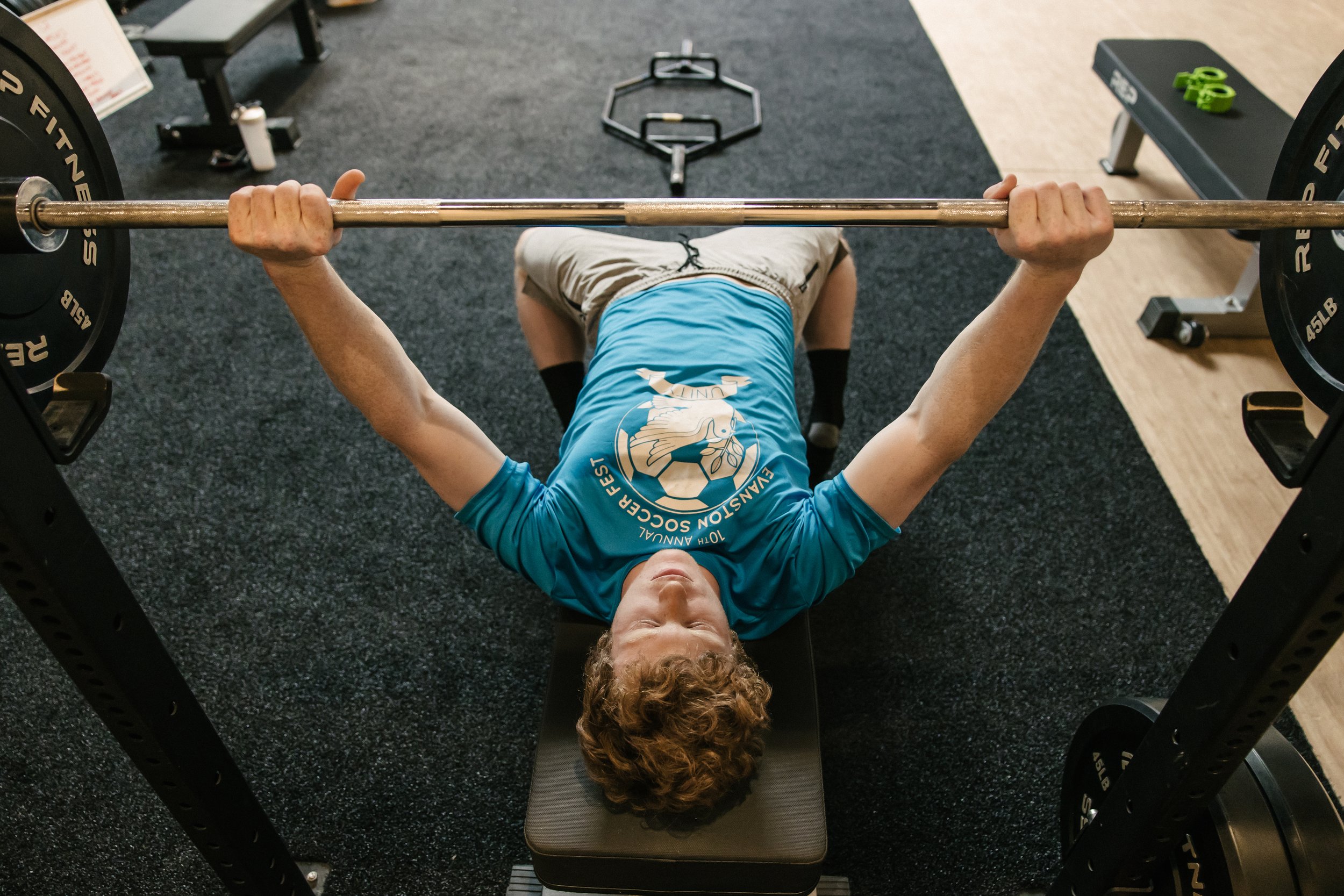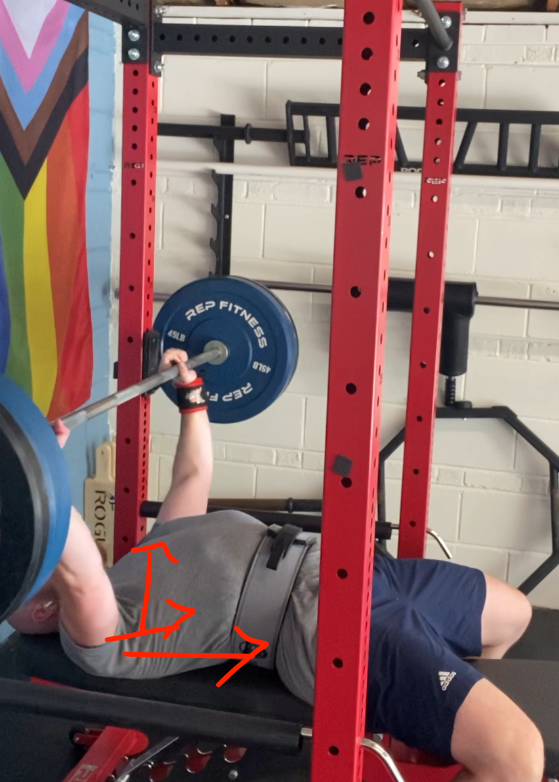Understanding the Muscles Used During the Bench Press
The bench is a powerful for upper body strength and power. Knowing the anatomy of the chest gets you the most out of the movements.
Photo Credit: Becca Heuer
Introduction
Muscle activation has a massive impact on lifting. This is especially true in compound movements like barbell lifts that use multiple joints and muscles.
Proper technique and mastering the mind-muscle connection can maximize the benefits of movements like the barbell bench press. By actively targeting the correct muscles, you'll improve size and strength more efficiently.
That means you'll need to learn a little bit of anatomy.
This article delves into the primary, secondary, and supporting muscles involved in the bench press. We'll also cover variations and tips for maximizing your gains.
The Bench Press Works Out What Muscles?
The bench press primarily targets three major muscle groups: the pectorals, the anterior deltoids, and the triceps.
Pectoralis Major and Minor
The bench press primarily works the chest muscles, known as the pectoralis major and minor.
Pec major originates from the sternum, ribs, and collarbone, attaching to the upper arm bone (the humerus).
The pec minor is located beneath the pectoralis major. It helps stabilize the shoulder blades.
Images courtesy of Wikimedia:
https://commons.wikimedia.org/wiki/File:Pectoralis_minor.svg,
https://commons.wikimedia.org/wiki/File:Pectoralis_major.png
Anterior Deltoids
The anterior deltoids also play a vital role in the bench press but are secondary to the pecs. They're located at the front of the shoulder, which allows them to move the arm forward. They also stabilize the shoulder joint during the pressing motion.
You should pay attention to involving them more during the final portion of the lift. If you let your shoulders come off the bench or extend in front of the pecs, they will take on more load than necessary.
Instead, think about actively pushing through them in the final 1/3 of the lift. They become helpful - along with the triceps - once you've worked through the chest's range of motion.
Triceps Brachii
Like the front delts, the triceps brachii can assist with the lockout on the bench press. As the lift progresses and the arms straighten, strong triceps can help to fully extend to the elbow.
This makes sense when you consider the triceps location. They're a group of three muscles (hence "tri) located on the back of the upper arm, making them an antagonist for the bicep.
Later in this article, we'll cover specific movements to strengthen the triceps in crucial positions for the bench press.
Engaging the Pecs on the Bench Press
Targeting the pecs begins by correctly setting your back.
A strong foundation on the bench ensures stability while pushing the pecs above the front shoulders.
To achieve this position, center your body on the bench before lying back. Once your eyes are directly under the bar, pinch your shoulder blades together while pulling them toward your back pocket.
What Secondary Muscles Are Involved?
In addition to the primary muscles, several secondary muscles assist in the bench press. Most of these provide stability or power.
Remember, the bench press is a compound movement. So, while we don't want secondary muscles overshadowing the pecs, they can each add a small boost if used correctly.
Biceps Brachii
The biceps help stabilize the upper arm bone within the shoulder joint and assist with bending the arm at the shoulder and elbow. Weak stabilizers can contribute to injury by acting as the broken link in the chain. Strengthening the biceps ensures they can handle the bench loads and provide the necessary counter-force to the triceps.
Serratus Anterior
The serratus anterior is often called the "boxer's muscle" due to its location on the side of the chest.
Boxers often have highly developed serratus as they allow the shoulder blades to move forward (protract). When you throw a bunch, you rely on this muscle and its connection to the upper ribs to produce force in front of you.
In the context of the bench, as you extend upward, the serratus can transfer force from the chest and shoulders through the barbell.
Trapezius and Rhomboids
The upper back muscles serve as the foundation of the bench press. They allow you to pull the shoulder blades back, giving you more support on the bench. Contracting them throughout a set prevents any power leaks.
Core
The core stabilizes your entire body during any barbell lift. In the case of the bench press, maintaining rigidity in the upper body translates into more power. You're leaking power if you find yourself wiggling throughout a set.
For the bench, prioritize dynamic core movements like Paloff presses, hollow holds, and farmers' carries. These exercises mimic the demands of lifting, which develops proper breathing control. Focus on inhaling deeply, sending the air into the belly. As you fatigue, continue to pressurize the belly, which protects the spine and gives you an extra edge during heavy sets.
Bench Press Variations
Developing as a lifter requires a mix of different tactics and strategies. The bench press specifically requires a lot of volume, and you can keep the gains coming by using variations that target weak points and provide novel stimuli. Here are a few of my favorites:
Incline Bench Press
Decline Bench Press
Close Grip Bench Press
Pause Bench Press
Pin Press
Block Bench
Spoto Press
Deficit Pushups
Assistance Movements
In addition to direct chest work, address the secondary muscles mentioned above. You should include two types of complementary movements. The first emphasizes overhead pressing from different angles, while the second stimulates the muscles in ranges specific to the bench press. These include:
Pin JM Presses
Banded Skullcrushers
Front Raises
Single Arm Overhead Dumbbell Presses
Cable Tricep Pushdowns
Cable Overhead Tricep Extension
Overhead Barbell Press
Overhead Barbell Pin Press
Trap Bar Shrugs
Single Arm Lat Pulls
Landmine Rotations
Technical Tips Maximizing Your Bench Press
Below is an overview of the key technical considerations for the bench. Read my article for more information.
Retracing and depressing the shoulder helps bring the chest in front of he deltoids, forcing the pecs to work harder.
The proper form begins right when you sit down on the bench. Start with your body at the front of the bench so you can use the middle post to center your body.
After you lay down, pull yourself back so that the barbell lines up above your eyes in the rack.
Pull your shoulder blades together and down toward your butt. It should feel like your entire back is rigid.
Grab the bar with both hands. Drive yourself into the bench by pressing against the bar.
Breathe deeply into the belly. Your stomach should expand with air while your chest stays still.
Bring your feet back as far as you can toward your butt while keeping them flat on the ground
Unrack the bar, ensuring that both elbows stay locked.
As you begin the descent, plan for the bar to touch the chest just below the nipple line.
Control the descent, paying particular attention to staying tight at the bottom. Many people are urged to "bounce" the bar off the chest - avoid it at all costs! This releases all the tension and energy you've created up to this point.
Squeeze your chest as it touches the bar, then press as hard and fast as you can.
As the bar travels up, you will lose a little speed. When that happens, squeeze the triceps with maximal effort.
Other Considerations for the Bench Press
Frequency and Consistency
Mastering anatomy and technique will only get you so far in achieving your strength goals.
Our bodies require a moderate to high amount of bench volume applied consistently. For beginners to intermediates, that equates to 15-20 sets split over 2-3 days.
Differences in age, experience, and injury drive that large range. You'll need to run experiments over a few mesocycles to refine your ideal volume - the amount that drives maximal progress and recovery.
Consistency matters as well. Let's say you bench twice weekly, with eight sets on day one and four sets on day two, during which you typically perform reps of 8. Now, assume you skip your second bench day every other week.
It seems like no big deal at the time, but your missed sets total almost 100 over the year. That's 800 quality reps per year you're losing!
Recovery
By the same token, just blasting through volume will hamper gains if you're under-recovered. A good rule of thumb is that you should be able to close to 100% for each of your sessions. That means your soreness or achiness should be gone within 48 hours.
You can speed up the recovery process with a few easy steps:
Make sure that during most of your sessions you’re only working to about an 8 out 10
As soon as you finish your workout, take 5 minutes to do deep breathing exercises or meditate
Focus on finding moments for quiet, relaxing time doing whatever activities you enjoy
Maximize how much sleep you can get
Conclusion
The bench press is a core barbell lift. Make sure you prominently feature it in your lifting program if you're emphasizing upper-body strength.
You'll achieve better gains by learning to recruit the pectoralis major and minor. In addition, you can design a program with the right variations to target the secondary muscles like the triceps and front delts. Optimal technique will guide the mind-muscle connection, while your long-term progress comes down to consistency, frequency, and recovery.
For a deeper dive into bench press mastery check out my article here.
References
https://characterstrength.co.uk/post/what-muscle-does-bench-press-work-diagram-guide-and-exercise-variations
https://www.healthline.com/health/exercise-fitness/bench-press-muscles-worked
https://www.webmd.com/fitness-exercise/how-to-bench-press
https://www.garagegymreviews.com/what-muscles-does-bench-press-work
https://www.livescience.com/bench-press-muscles-worked
https://www.strengthlog.com/bench-press/
https://www.muscleandmotion.com/how-to-bench-press-properly/
https://www.nike.com/a/bench-press-muscles-worked
https://www.barbellmedicine.com/blog/how-to-bench-press/
https://ptskills.co.uk/muscles-used-in-the-bench-press/
https://www.bodybuilding.com/content/bench-press-blunders-dont-let-these-8-mistakes-sabotage-your-bench.html
https://blog.nasm.org/biomechanics-of-the-bench-press
https://www.bodybuilding.com/content/how-to-bench-press-layne-norton-complete-guide.html
https://www.bodybuilding.com/fun/schultz50.htm
https://www.ncbi.nlm.nih.gov/pmc/articles/PMC6835758/




